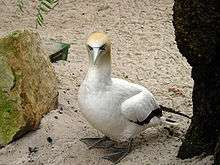Australasian gannet
| Australasian gannet | |
|---|---|
 | |
| | |
| Scientific classification | |
| Kingdom: | Animalia |
| Phylum: | Chordata |
| Class: | Aves |
| Order: | Suliformes |
| Family: | Sulidae |
| Genus: | Morus |
| Species: | M. serrator |
| Binomial name | |
| Morus serrator Gray, 1843 | |
| | |
| Australasian gannet range | |
The Australasian gannet (Morus serrator or Sula bassana), also known as Australian gannet and Tākapu, is a large seabird of the gannet family Sulidae.
Adults are mostly white, with black flight feathers at the wingtips and lining the trailing edge of the wing. The central tail feathers are also black. The head is yellow, with a pale blue-grey bill edged in black, and blue-rimmed eyes.
Young birds have mottled plumage in their first year, dark above and light below. The head is an intermediate mottled grey, with a dark bill. The birds gradually acquire more white in subsequent seasons until they reach maturity after five years.
Their breeding habitat is on islands and the coast of New Zealand, Victoria and Tasmania, with 87% of the adult population in New Zealand. They normally nest in large colonies on coastal islands. In New Zealand there are colonies of over 10,000 breeding pairs each at Three Kings Islands, Whakaari / White Island and Gannet Island. There is a large protected colony on the mainland at Cape Kidnappers (6,500 pairs). There are also mainland colonies at Muriwai and Farewell Spit, as well as numerous other island colonies.[2]
Gannet pairs may remain together over several seasons. They perform elaborate greeting rituals at the nest, stretching their bills and necks skywards and gently tapping bills together. The adults mainly stay close to colonies, whilst the younger birds disperse.
These birds are plunge divers and spectacular fishers, plunging into the ocean at high speed. They mainly eat squid and forage fish which school near the surface. It has the same colours and similar appearance to the northern gannet.
Numbers of Australasian gannet have been increasing since 1950, although some colonies have disappeared and others have decreased in size.
References
| Wikispecies has information related to: Morus serrator |
| Wikimedia Commons has media related to Morus serrator. |
- ↑ BirdLife International (2012). "Morus serrator". IUCN Red List of Threatened Species. Version 2013.2. International Union for Conservation of Nature. Retrieved 26 November 2013.
- ↑ Maggy Wassilieff. Gannets and boobies - Gannets: description and habitat, Te Ara - the Encyclopedia of New Zealand. Wellington: Ministry for Culture and Heritage. Updated 13 July 2012.
Gallery
-

Juvenile, Cape Kidnappers
-
Video of a noisy colony
-

Breeding colony at Muriwai, New Zealand
-
Dense colony at Muriwai

%2C_Cape_Kidnappers_colony.ogg.jpg)
